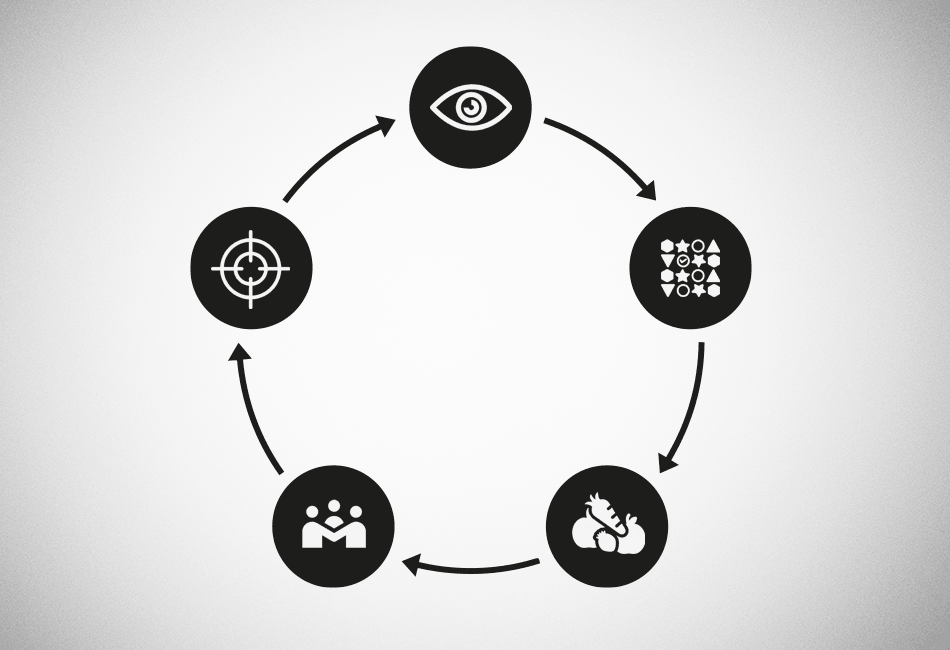By creating a fitness routine you provide yourself with a structured approach to gaining and then maintaining a strong, healthy body and a strong healthy mind.[1] Creating a structured fitness routine, of course, is easy. All you need is a coach, a nutritionist, several trainers who will design specific workouts, a sports psychologists or two and a support team. These are all the elements that go into the making of elite athletes. On days when their motivation fails they still get to experience an acceptably high level of physical exercise and mental focus, thanks to the people around them.
You may not be an elite athlete who is part of a national sports team that is supported by a whole lot of other professionals but that doesn’t mean you can’t benefit from the same smart system that helps them maintain their focus.
So, what is it you need to put together?
1. Visualization
The power of the mind to affect fitness is undeniable. New studies show that by visualizing our self, performing a specific physical activity[2] we are priming our brain and body to do it. What’s more we prime our self to do it well even when we don’t really feel like it.
The power of visualization to help us overcome obstacles is so well documented that there are now studies on how it can be used in sports rehabilitation[3] to help overcome sports-related injuries faster.[4]
Visualization or mental role playing helps the brain allocate attention. This changes the way mental resources are apportioned and focus is directed. The brain is absorbed in the role that’s visualized and many of the obstacles that prevent us from exercising, such as tiredness perhaps, stress, lack of organization, are diminished in our perception and removed.
Role-Playing Programs (RPG) like Hero’s Journey or Age of Pandora or Carbon & Dust create an immersive, interactive fitness experience with a rich storyline that makes it easy to focus away from the difficulties usually associated with exercise. Instead you can become an unexpected hero undertaking a journey of personal transformation, the saviour of a world that may be doomed to fail or the unwilling hero who will save the galaxy and change the balance of power.
If a program represents too much of a commitment there are many RPG workouts that have the same effect and are a great way to dive into visualization and exercise.
2. Focus
Exercise is the means through which we reprogram the body and brain. Even a single session of physical exercise affects our memory and improves our ability to learn[5]. Sustained exercise helps the brain create thicker, better connections that lead to improved cognitive function.[6]
All this are the result of exercising. In order to do so in the first instance, even when we don’t feel like it we need to be able to focus on something that is important to us. Something that will get us moving even on days when we don’t want to. Professional athletes have their coaches and they have a structure to their day. Those of us who try to fit exercise around a day job have to find other ways to create the structured approach we need.
The trick is to find a way to activate the brain’s reward system[7] so that a dopamine spike is experienced each time which leads to associating exercise with a pleasurable sensation and some anticipation. Keeping track of exercise[8] with a fitness tracker or a diary of workouts done, for example, working on a monthly challenge where each day is crossed out, working towards a realistic and specific goal such as improving the number of push-ups you can do, for example, or the distance you can run or the length of time you can exercise.
These are goals which provide a focus. To be able to use this to motivate our self even when we feel tired, low and dispirited we must have a clear target that is achievable, a finite period of time to achieve it in providing us with an end in sight and a clear means of recording it all in a way that shows progression towards our goal. Crossing days out in a diary or a calendar, for example, is one way of doing this. Counting marbles that are put from one jar to another, crossing out tally marks or bar gates on a notepad, basically you use whatever works easiest for you, as long as it motivates you to keep on going.
3. Variety
The next element we need is a means of maximizing the benefits of the time we invest in exercise. Because we haven’t got hours and hours to waste we need to be able to get the most from whatever time we put in. That could be as little as 10 minutes if we use micro-workouts to keep fit or as 15-20 minutes or even an hour.
The point is we need to benefit the most, and the only way we can really do that is by providing our muscles with a mixed bag of exercises each time.[9] That way the body doesn’t optimize its fitness routines, we stay fresh and motivated as boredom doesn’t get the chance to set in and we see fitness and health benefits much faster.[10]
By choosing a variety of workouts, changing up and even sometimes changing down the tempo of our exercise routines and also trying various types of exercises we ensure that the stimulus to which the body responds with adaptations, remains fresh and challenging.
4. Nutrition
Food is fuel. The quality of the fuel we ingest determines how quickly out body responds to the physical, mental and psychological demands being made of it. Research shows that there is a direct link between building strength and a diet that supports it[11]. There is also a direct link between what we eat, long-term and how it affects bone strength[12] which, in turn, affects the health of our brain.
Most of us are locked into some type of eating routine because we like it, we find it easy to use and we are accustomed to it. By experimenting with healthier options and small reductions in the ingestion of food stuffs like saturated fats and sugar that we know are harmful to us we can deliver small, consistent boosts to our fitness and overall health.
5. Support
Alone we often fail. Sustaining a weightloss or health and fitness drive, entirely on our own soon depletes our mental and physical resources and makes it hard for us to stick to it. This is where emotional support really helps. Studies have shown that weightloss and fitness routines undertaken in a virtual[13] or real-world community setting[14] deliver better results by helping the participants stick to what they are doing when they feel low.
Within Darebee there is a helpful online community, The Hive. Just logging on and reading other people’s posts is of immense help. It shows that everyone faces some issue at some point. Overcoming it takes effort and it is always a little difficult. The small change of perspective afforded by reading other people’s fitness journeys is sometimes sufficient to help us find our own motivation[15] and stay on track.
Conclusion
Creating a fitness routine that is life-changing and sustainable is not rocket science. It does, however, require a planned approach that takes into account all the various elements that go into it. The benefits of this approach deliver superior results both physically and mentally.
References
- Warburton DE, Nicol CW, Bredin SS. Health benefits of physical activity: the evidence. CMAJ. 2006;174(6):801-809. doi:10.1503/cmaj.051351
- Predoiu, Radu & Predoiu, Alexandra & Mitrache, Georgeta & Firanescu, Madalina & Cosma, Germina & Dinuta, Gheorghe & Bucuroiu, Razvan. (2020). Visualisation techniques in sport - the mental road map for success. 59. 245-256. 10.35189/dpeskj.2020.59.3.4.
- Evans, Lynne & Hare, Rebecca & Mullen, Richard. (2006). Imagery Use During Rehabilitation from Injury. Journal of Imagery Research in Sport and Physical Activity. 1. 10.2202/1932-0191.1000.
- Sordoni, C. et al. “The Use of Imagery by Athletes During Injury Rehabilitation.” Journal of Sport Rehabilitation 9 (2000): 329-338.
- Blomstrand P, Engvall J. Effects of a single exercise workout on memory and learning functions in young adults—A systematic review. Transl Sports Med. 2020:1–13. doi:10.1002/tsm2.190
- Chaddock-Heyman L, Erickson KI, Kienzler C, et al. The role of aerobic fitness in cortical thickness and mathematics achievement in preadolescent children. PLOS ONE. 2015;10(9):e0138166. doi:10.1371/journal.pone.0134115
- Huberty JL, Ransdell LB, Sidman C, Flohr JA, Shultz B, Grosshans O, Durrant L. Explaining long-term exercise adherence in women who complete a structured exercise program. Res Q Exerc Sport. 2008 Sep;79(3):374-84. doi: 10.1080/02701367.2008.10599501. PMID: 18816949.
- Lewis ZH, Pritting L, Picazo AL, JeanMarie-Tucker M. The utility of wearable fitness trackers and implications for increased engagement: An exploratory, mixed methods observational study. Digit Health. 2020;6:2055207619900059. Published 2020 Jan 13. doi:10.1177/2055207619900059
- Fonseca RM, Roschel H, Tricoli V, de Souza EO, Wilson JM, Laurentino GC, Aihara AY, de Souza Leão AR, Ugrinowitsch C. Changes in exercises are more effective than in loading schemes to improve muscle strength. J Strength Cond Res. 2014 Nov;28(11):3085-92. doi: 10.1519/JSC.0000000000000539. PMID: 24832974.
- Clark JE. The impact of duration on effectiveness of exercise, the implication for periodization of training and goal setting for individuals who are overfat, a meta-analysis. Biol Sport. 2016;33(4):309-333. doi:10.5604/20831862.1212974
- Robinson S, Granic A, Sayer AA. Nutrition and Muscle Strength, As the Key Component of Sarcopenia: An Overview of Current Evidence. Nutrients. 2019;11(12):2942. Published 2019 Dec 3. doi:10.3390/nu11122942
- Mithal, Ambrish & Bonjour, jean-philippe & Boonen, S & Burckhardt, P & Degens, Hans & El-Hajj Fuleihan, Ghada & Josse, R & Lips, P & Torres, J & Rizzoli, R & Yoshimura, N & Wahl, Denys & Cooper, C & Dawson-Hughes, B. (2012). Impact of nutrition on muscle mass, strength, and performance in older adults. Osteoporosis international : a journal established as result of cooperation between the European Foundation for Osteoporosis and the National Osteoporosis Foundation of the USA. 24. 10.1007/s00198-012-2236-y.
- Hwang KO, Ottenbacher AJ, Green AP, et al. Social support in an Internet weight loss community. Int J Med Inform. 2010;79(1):5-13. doi:10.1016/j.ijmedinf.2009.10.003
- Stødle, I.V., Debesay, J., Pajalic, Z. et al. The experience of motivation and adherence to group-based exercise of Norwegians aged 80 and more: a qualitative study. Arch Public Health 77, 26 (2019).
- Brand Ralf, Cheval Boris. Theories to Explain Exercise Motivation and Physical Inactivity: Ways of Expanding Our Current Theoretical Perspective. Frontiers in Psychology, 10, 2019. 1147. DOI:10.3389/fpsyg.2019.01147. ISSN: 1664-1078.








